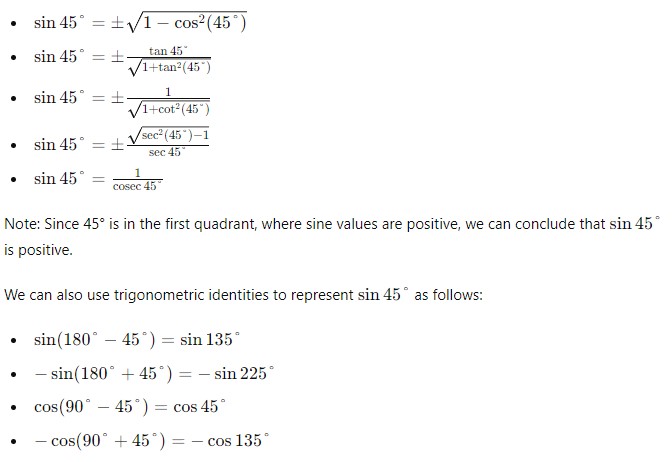Sin 45°
The sine of 45 degrees is approximately 0.7071067.
In radians, this angle is expressed as sin(45° × π/180°), which simplifies to sin(π/4) or sin(0.785398...).
Therefore, sin(45°) is roughly equal to 0.7071067.
In fractional form, sin(45°) can be written as 1/√2.
The sine of -45 degrees is -0.7071067.
In radians, sin(45°) is sin(π/4) or sin(0.7853981...).
Also Check: Value of Sin 60 Degree
Value of Sin 45 Degrees
The value of sin 45 degrees is approximately 0.707106781.
When this angle is expressed in radians, it is about 0.78539.
Conversion from Degree to radian
The formula to convert degrees to radians is: θ (radians) = θ (degrees) × (π/180°)
For example, 45 degrees can be converted to radians as follows:
45° × (π/180°) = π/4 or approximately 0.7853.
Therefore, sin(45°) is equivalent to sin(0.7853), which equals 1/√2 or approximately 0.7071067.
Detailed solution:
The angle of 45° falls within the first quadrant (0° to 90°), where the sine function is positive. Hence, the value of sin 45° is 1/√2 or approximately 0.7071067. Since the sine function is periodic, we can express sin 45° as sin(45° + n × 360°), where n is an integer (n ∈ Z). Therefore, sin 45° is equivalent to sin 405°, sin 765°, and so on.
Note: sine is an odd function, sin(-45°) = -sin(45°).
Methods to Find Value of Sin 45 Degrees
Since we know that in the first quadrant, the sine function is positive, we can find the value of sin 45° to be approximately 0.7071. This can be determined using both the Unit Circle and trigonometric functions.
Explanation of Sin 45 Degrees Using the Unit Circle:
To find sin 45° using the Unit Circle, rotate the radius rrr counterclockwise to form a 45° angle with the positive x-axis. The sine of 45 degrees corresponds to the y-coordinate (0.7071) of the intersection point (0.7071, 0.7071) on the unit circle. Therefore, sin 45° ≈ 0.7071.
Sin 45° in Terms of Trigonometric Functions
Using trigonometric formulas, we can express sine of 45 degrees in various ways:

Frequently Asked Questions
The derivative of sin 45° is cos 45°, which is equal to 1/√2 or approximately 0.7071067812
The inverse sine of 45° is 45°, which is equal to π/4 radians.
Yes, the values of sin 45° and cos 45° are equal, both being 1/√2 or approximately 0.7071067812.
The sine of 45° is 1/√2 or approximately 0.7071067812, while the cosine of 45° is also 1/√2 or approximately 0.7071067812.
The value of sin 45° is 1/√2 or approximately 0.7071067812. It can be derived using the Pythagorean theorem in a 45-45-90 right triangle.